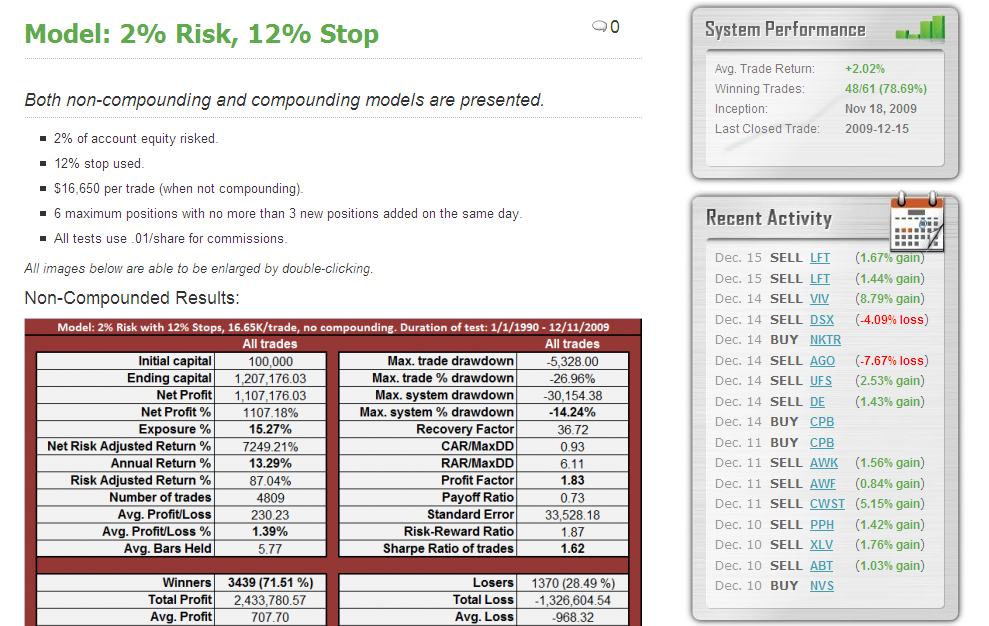Link to Part 1.
Part 1 established the following:
- A stock’s movement is its volatility.
- Average True Range (ATR) is a measure of volatility.
- ATR can be used to position-size to account for volatility.
And we examined the chart below and performed some calculations…
Using the ATR(10) indicator in the bottom pane of the chart, we divided the ATR(10) by the close and multiplied that result by 100 to get a percentage.
(.803/$33.91=0.023)*100=2.3%
It is important to for anyone wanting to explore ATR position-sizing to know how to figure out what 1ATR equals in percentage terms. If 1ATR=2.3%, then 3ATR=6.9%. I’ll jump a couple of steps ahead and say that if a 3ATR stop is applied to MHP, it will be -6.9% beneath its close of $33.91
We now have most of the information we need to position-size and set a stop using ATR.
Here are the 4 necessary pieces of information to position-size using ATR:
- ATR(10) calculation, readily available at Stockcharts. (I prefer a 10 period setting but the default setting is 14).
- The ATR multiple, or what number you will use to multiply by the ATR (typically between 1.5 to 5).
- The most recent closing price.
- How much $$$ to be risked. (We will use 1% of equity as our amount to be risked).
Here is the ATR Position-Size Calculation:
(R/(ATR*M))*C=position-size
Where R=risked amount.
ATR = Average True Range with a period setting.
M= Multiple applied to ATR.
C= Most recent closing price.
Assuming account equity of 100K and 1% risk, our 3ATR position-size calculation for The McGraw-Hill Companies, Inc. [[MHP]] would look like this:
($1,000/(.803*3)) =415 shares
415*$33.91 = $14072.65 position-size
The easy part is that the stop is already calculated- it is simply the ATR multiplied by the multiple (we used 3). So the stop is .803*3 = $2.409
Lets look at another example:
Above is [[TPI]] , which was the PDS pick on Wednesday evening. Yes, it is another gorgeous pullback, the kind that the PDS finds daily.
Let’s run through the calculations, using the same parameters, with a 3 multiple for the ATR.
$1000/(.322*3)=1035 shares (We would complete this calculation the night before, and put in the order for that number of shares. Remember that $1,000 is 1% of our equity and the amount we are risking.)
1035*$4.27 = $4419.45 position-size (On Thursday morning, TPI opened at $4.27).
Stop = .966 beneath the entry of $4.27
Let’s Make Sense of It All
Carefully note the following:
Both MHP and TPI used an ATR multiple of 3 to position-size, yet this yielded two completely different sized positions.
For example, the MHP position is over 3x larger than the TPI position, yet the TPI stop is 3x wider than the MHP stop.
MHP position = $14,072 with a -6.9% stop.
TPI position = 4419.45 with a -22.6% stop.
What does it all mean?
The simplest way to understand it is that TPI is more volatile than MHP. Thus, we take a smaller position in TPI and use a wider stop.
Since MHP is less volatile, we might expect it to move 2% in our favor, while we might look for the more volatile TPI to move 6%. (In fact, MHP was closed on 12/24 for a 1.45% gain.)
MHP = 14,072*2% = $281.44 profit.
TPI = 4419.45*6% = $265.17 profit.
Even though the TPI position is smaller, we know that it can earn similar profits to the larger-sized position in MHP.
It is always fun to think about profits, but it is equally important to consider losses. If we took an equal-sized position in TPI as we did in MHP, how would it feel to have TPI move 7-14% against us? It would hurt, yet we should expect that TPI could move that quickly as its average daily range has been over 7%.
Theoretically, building positions that account for volatility help ensure that each position will add the same amount of “heat” to the portfolio. In other words, if you have loaded up with 5 volatile penny stocks, volatility position-sizing will have you buying 5 small positions, leaving a significant amount of cash. Conversely, if you want to fill your portfolio with blue chip stocks (which are typically not relatively volatile), then volatility position-sizing will have you buying a few large positions, and will probably use most of your cash. To see this balance in action, you could buy 7 positions in stocks similar to MHP, using all of your 100K. If you bought 7 positions in stocks similar to TPI, you would have used only 30% of your cash.
Finally, the ATR multiple, be it 1.5, 3, or 5, determines how aggressive your allocations are. A lower ATR multiple will result in larger positions with smaller stops.
Questions and Comments?
If you have any questions or anything I have presented is unclear, please speak up in the comments section.
The PDS site includes a 2% risk, 3ATR model that earned 64.64% annualized, with an average trade profit of 1.65%.
Comments »



















